Welcome back to The Journey, where we follow hockey prospects and their paths to the NHL, providing fantasy predictions and analysis along the way.
It’s the end of the month again, which means it’s time for another edition of sink-or-swim. We'll examine three former blue-chip prospects whose values have taken a hit and whose futures now seem uncertain. Should you trade them while they still have name recognition or hold until/buy low before they turn things around and get back to their dynamic ways?
Post ideas for future players in the comments or hit me up on Twitter @beegare. Past editions have looked at Kaapo Kakko, Erik Brannstrom, Eeli Tolvanen, Juuso Valimaki, Kailer Yamamoto, Nick Robertson, Cody Glass, Owen Tippett, and Jack Roslovic. This month, the spotlight is on Filip Zadina, Kirby Dach, and David Farrance.
Filip Zadina, DET
Red Wings fans don't seem ready to give up on Zadina yet, but the guy sure is a lightning rod for strong opinions—both for and against. That'll happen when you're selected 6th overall ahead of Quinn Hughes, Evan Bouchard, Joel Farabee and others who seem more on track to consistency and stardom. Instead of dumping on Zadina, however, Red Wings Twitter seems more annoyed with his inconsistent deployment at the hands of Coach Jeff Blashill.
Here's the lowdown on Zadina's usage: he's played about 90 minutes (12% of his total time on ice) with Dylan Larkin and Lucas Raymond on the top line, including during a recent game against the Flyers. Metrics-wise, that line has done merely okay together: slightly more goals for than against, slightly fewer shot attempts and scoring chances. Zadina has also spent a fair amount of time (16% of TOI) down on the fourth line with Adam Erne and Michael Rasmussen; that line consistently gets dominated and doesn't seem like a good fit for a player billed as a scoring sniper type. His most common linemates, Robby Fabbri and Pius Suter (20% of TOI), have worked well with Zadina to form a solid trio: although they've been outscored 6-3, they've done a great job controlling shot attempts and scoring chances.
The inconsistent usage might not all be on Blashill's shoulders: Fabbri went down with a knee injury recently, Jakub Vrana returned from a season-long shoulder injury in early March, and Oskar Sundqvist replaced Vladislav Namestnikov via trade after the deadline. This is a young team in flux who are still figuring out where everyone fits. Joe Veleno is starting to look more comfortable and dynamic, and next year, exciting playmaker Jonatan Berggren (40 points in 53 AHL games as a rookie) will likely join the mix too, giving the Wings a ton of options to roll out in their top nine.
Although Zadina's power play time has dropped by 10% and his ice time is down over two minutes from last year, the Kotkaniemi Treatment (™) is agreeing with him: he's consistently driving play in a sheltered capacity—one of the better players on the team this year for that in fact—and as we've seen, he's accomplished that without consistent linemates.
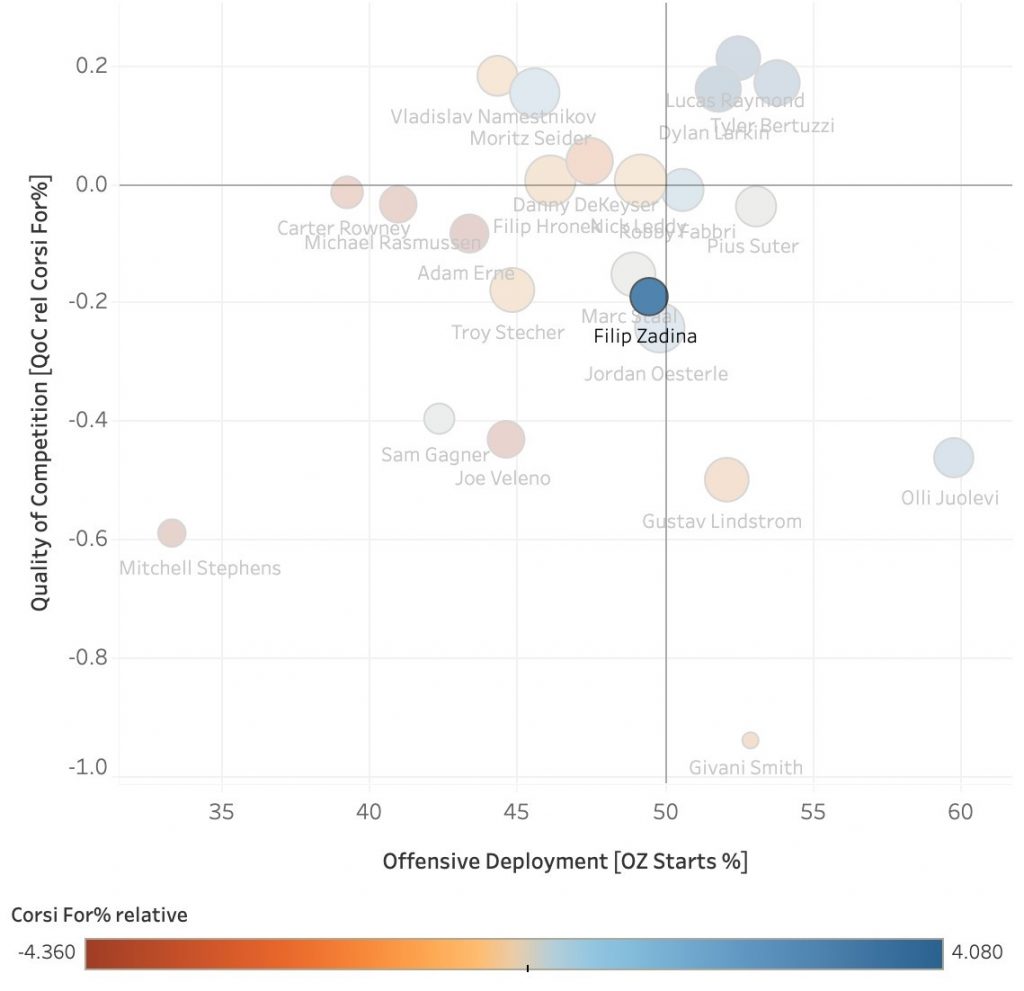
Other positive signs for Zadina: he'll hit his Breakout Threshold about 30 games into next year, he's been consistently unlucky (960 PDO), and he's shown an incredible aptitude for the power play. He's averaged just under two minutes per game with the man advantage this year but has been involved in a whopping 90% of power play goals scored with him on the ice. Even if and when that regresses closer to the mean, it suggests that Zadina will continue growing into a proficient power-play specialist. If he can get steady top-six deployment next to a skilled playmaker like Raymond or Berggren, Zadina might still have a chance to live up to his shiny draft pedigree. He'd make a great speculative buy-low candidate in the offseason if the owner in your league is frustrated by his career 30-point pace since 2018.
Kirby Dach, CHI
The first thing to remember about Dach is that his size likely doubles the time it’ll take him to fully hit his stride in the NHL. That means Dach still has three full seasons between his current 30-point pace and whatever his eventual upside ends up being. Expect his production to improve a bit every year until he ends up somewhere north of 65 points.
What will the Blackhawks look like three years from now? Both Patrick Kane and Jonathan Toews will be 36. Their roles and production will slowly decline as they push further into their thirties—and they're both UFA after next season so there's no guarantee that either or both will finish their careers in the Windy City.
Moving forward, Dach, Alex DeBrincat, and Seth Jones are the core of this team, and there isn't a lot of help on the way. Lukas Reichel (44 points in 43 AHL games) is looking like a solid complementary piece. Same with Ian Mitchell (28 points in 47 AHL games) on the back end. Brandon Hagel looked like a solid player to build around, but they flipped him to the Lightning at the deadline for late first round picks in the next two drafts. But really, there's not a lot of support coming. There will be tough years ahead for this team, which doesn't bode well for Dach's longer term outlook. His role will increase but his production will likely suffer. He’s already facing the highest quality competition on the team and isn’t getting too many offensive zone draws. That’s starting to sound a lot like a less talented Jonathan Toews.
He spent the first half of the season stapled to Kane and DeBrincat but only put up 14 points in 40 games. Unsurprisingly, given how prolific that duo has been, Dach's IPP is way down in the low 40s (high-end forwards should be 70+) at both even strength and on the power play. For whatever reason, he's just not involved in goals scored while he's on the ice. He's not contributing in other categories that would help make him rosterable in fantasy either: under two shots and barely half a hit per game, and he's a paltry 33% at the faceoff dot.
The only positives with Dach are his size, opportunity, and draft pedigree. In fantasy, let someone else swing (and wait) on his upside. If he has any name value left in your league after going third overall in 2019, perhaps you can leverage that faint glimmer to acquire a player with fewer question marks and a shorter timeline.
David Farrance, NAS
Farrance was an attractive stash over the last couple years in fantasy because of his insane production as a defenseman in college: in 2019-20 he scored a remarkable 43 points in 34 games and followed that up with 16 in 11 the following year. These would be incredible totals for a forward but are all but unheard of for a blueliner. But this year he made the jump to the AHL and put up a very underwhelming 14 points in 46 games. That places him fifth among defensemen on the Admirals in scoring—not the kind of production you'd expect from such a prolific college athlete.
So what happened?
For one, it's somewhat unusual for top NHL prospects playing in college to stay for all four years as Farrance did. Over the time he spent at Boston University, Farrance was teammates with players like Trevor Zegras, Brady Tkachuk, and Joel Farabee, all of whom were one and done and have now assumed roles with their respective NHL clubs. It's interesting to note, then, that his production as a freshman and sophomore (29 points in 68 games) wasn't particularly special. It wasn't until his junior season that his PNHLe (40 → 85) and star potential (3% → 17%) went through the roof.

Two things happened that year that help explain his explosion: Trevor Zegras joined BU and Dante Fabbro, their top defenseman for the previous couple years, graduated to the Predators. Zegras put up 36 points in 33 games as a freshman and led the team in power play assists with 14. Meanwhile, Farrance took over three shots per game (up from 1.7 the year before) and accounted for over 30% of BU's power play goals.
So Farrance clearly thrived as his team's top defender running the power play alongside an elite playmaker. But how much of that incredible season was him and how much was the Zegras Effect? It's hard to say. The year before, BU's dynamic duo was Farabee and Fabbro, who put up a combined 69 points in 75 games—versus a much more impressive 79 in 67 for Farrance and Zegras. Fabbro shot slightly less than Farrance did and was more of a distributor than goal-scorer—a trend that has continued so far in the NHL (1.4 shots per game career average). My hunch is that Farrance is more offensively inclined than Fabbro, who is more of a complete defender, and that playing with Zegras also inflated his stats more than many fantasy managers (myself included) realized.
But that angle doesn't account for the 16 points Farrance scored in only 11 games the year after Zegras moved on to the AHL. His main running mates that year were Jay O'Brien (PHI, 2018 1st round) and Luke Tuch (MON, 2020 2nd round), both of whom are likely to make the NHL but more as depth players. Not Zegras-level teammates, in other words. Farrance's production in 2020-21 is even more remarkable when you consider that he only scored two points in his first five games before going down with an injury. After returning five games later, he put BU on his back with an absolutely insane 14 points in six games. That’s as a senior of course but still, if the NCAA season hadn't been cut short Farrance might have gone on to post historic numbers.
Will the real David Farrance please stand up?
The one thing that both of Farrance's monster college seasons have in common is that he was his team's undisputed top defenseman. It seems clear that he needs big minutes and lots of power play time to put points on the board—which shouldn't come as a surprise as it’s
true for most players. This year in the AHL, for whatever reason, the opportunity just hasn't been there for him. He's taking barely a shot per game and has far more assists than goals on the power play (6 to 1). Ahead of him on the depth chart are career AHLer Matt Donovan and 7th round pick Jeremy Davies. I'm not sure what Coach Taylor's thought process is here but it's sure frustrating for those of us in fantasy who want to see what Farrance is capable of at the professional level.
This situation reminds me of Eeli Tolvanen's tenure with the Admirals: none of his stats really jumped off the board because he wasn't often showcased in a top-line role. Milwaukee is known for having a grinding, scrappy style and team-first mentality that means they often play their veterans over their rookies. For fantasy, Farrance remains a wait-and-see situation. I've parted ways with him in both leagues where I owned him coming into this year because his trade value was zilch and I needed the spots on my farm. If you can afford to be patient, however, there still might be a mid-tier offensive defenseman here. The best-case scenario would see Farrance take over the reins as the Admirals' top defenseman next year and start putting up points again.
A word of warning though: if he needs big minutes and PP time to be fantasy relevant, what's going to happen when he graduates to the Predators and runs into Roman Josi? Josi, the team captain, is only 31 and currently on a 103-point pace, so he's obviously not going anywhere. Farrance will either need to be traded somewhere he can feature more prominently in the offense or reinvent himself to some extent as someone who can contribute in other ways.
Thanks for reading! Follow me on Twitter @beegare for more prospect content and fantasy hockey analysis.

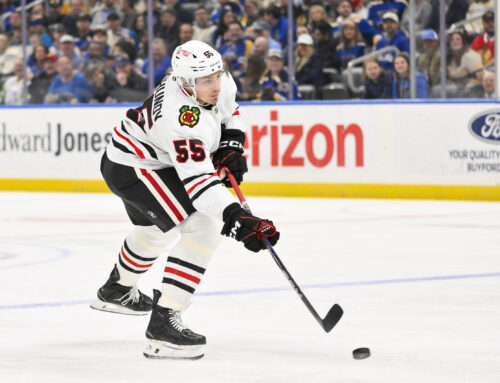
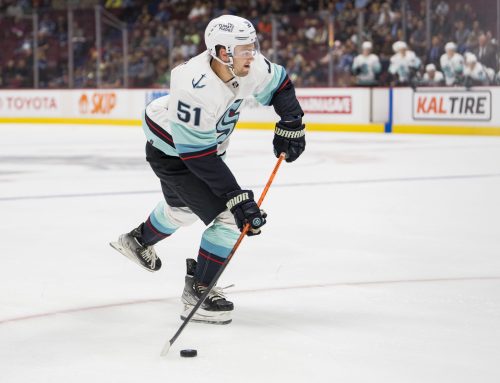
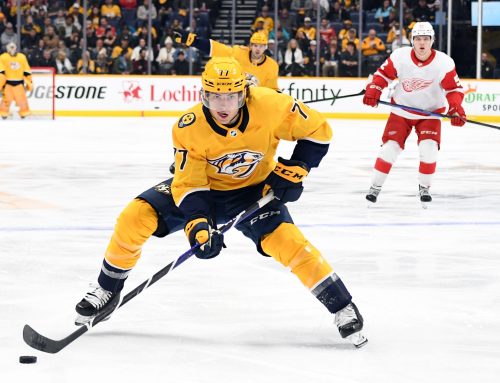
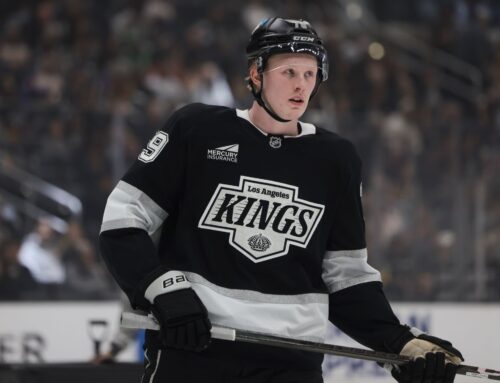
 OTT
OTT TOR
TOR MIN
MIN VGK
VGK COL
COL DAL
DAL EDM
EDM L.A
L.A CAR
CAR CHI
CHI STL
STL MTL
MTL WSH
WSH N.J
N.J
